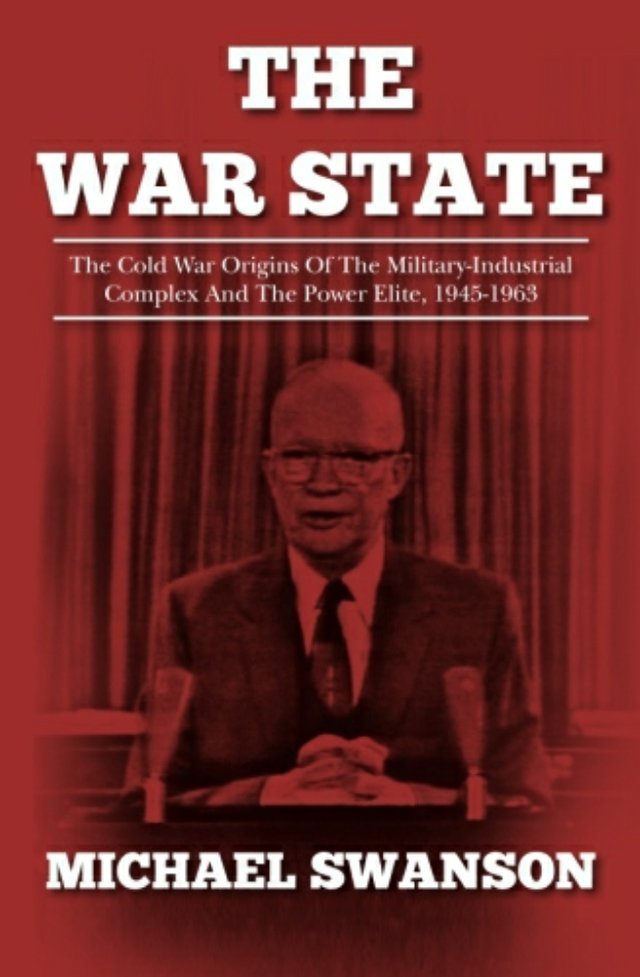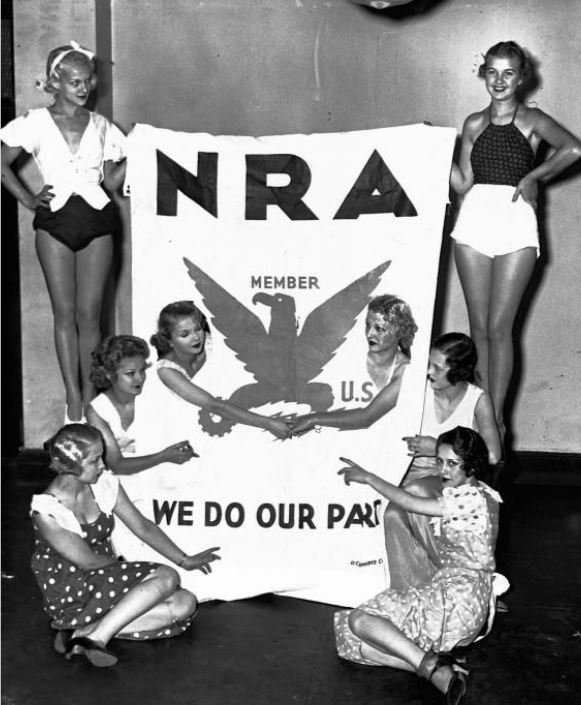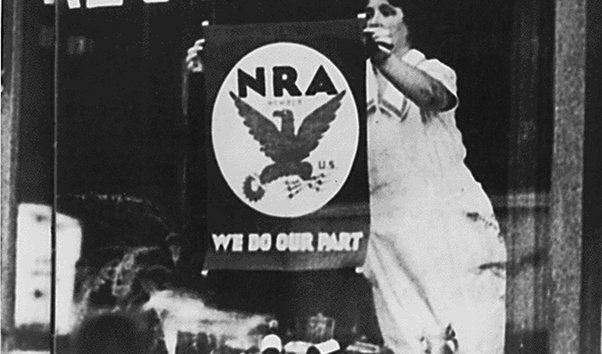A Serialized Book Summary, Analysis and Commentary on The War State, by Michael Swanson – Part Two

The following is part two of a three part series reviewing the book The War State, By Michael Swanson. Part One can be found here. If you are good with reading things out of sequence, then dig in to the article below!
Originally published on www.denverlibertarian.com
Part Two:
Funding Big Business - the Buildup

Taking the lead from President Woodrow Wilson during WWI, which saw an explosion in the number of new executive programs, Franklin Delano Roosevelt (FDR) ran with that concept and further expanded all aspects of government. This is to say nothing of his predecessor, Herbert Hoover, who was no stranger to government spending, despite the textbook claims that he was a, “strict supporter of laissez-faire economics [who] believed the government should never interfere in the economy,” as debunked by historian Tom Woods in the book 33 Questions About American History You’re Not Supposed to Ask (p.180). In reading the standard history books, FDR is typically described as an enemy of business. While stumping on the campaign trail, FDR often attacked businessmen who were popular scapegoats in the post-depression era. This business bashing continued into the first few years of his Presidency, but incentives matter, so how does one convince businesses to co-mingle with government after berating them year after year? The answer for FDR was to create a cartel and guarantee profits for select businesses. Swanson recounts this process as such:
...before the war started there weren’t a bunch of large plants owned by big companies just sitting around and waiting for orders. Big war production was a new thing and the federal government itself often paid for and built the factories used in the defense industry and then gave them to the companies for free once the war ended. Of the twenty-six billion dollars spent during the war to build plants, seventeen billion was financed by the government. Taxpayer money financed the growth of the private defense industry. (p.18) [emphasis added]

You're welcome? Simply put, the concept was to build factories through coercive taxation, hand them over to businessmen and eliminate competitive bidding for government contracts, effectively removing the moral hazard of risk taking that a normal business would typically incur. Indeed, Swanson states that, “all of a contractor’s working capital is provided for by the federal government and payments are often made well in advance...this makes for a form of corporate socialism in which all risks are placed on the shoulders of taxpayers while profits are given to privately owned and well-connected corporations. (p.20) [emphasis added] To be sure, from a broad conceptual level, there was nothing new about the government awarding money to defense contractors, but the difference was that prior to WWII, government accepted competitive bids from numerous companies and typically awarded the contract to the lowest bidder. After the creation of the War Production Board, “within a few months 74 percent of the contracts were simply awarded after negotiation and not through competitive bidding.” (p.18) Who would want to give up that kind of a business relationship? The War Production Board was all encompassing and fascist at its core as, “the board had the power not only to decide on the allocation of war contracts but also to prohibit production that it deemed unessential to the war effort...It even regulated the amount of fabric that could be used to make clothes, one effect of this being that women’s skirts had to be made shorter.” (p.17) Perhaps it was all worth it, eh?
Of course, there have always been entangled alliances between government and business and one can look to the U.S. in the 1830’s for an example, where obtaining corporate status involved getting a specific grant from the state legislature. This would in turn confer upon an entity an artificial person status that would grant limited liability and other legal benefits, as described in this article, by historian Anthony Comenga, in discussing the locofocos and the Free Soilers movements. This process unquestionably opened the door for corruption between business and government. The War State would build on this precedent and day by day, it’s power and influence would continue to grow.
Feeding the People and Sending them off to Slaughter
Once big business found itself sucked into government dependence, the everyday people just trying to put food on the table would follow suit with little complaint. If there is no job other than a government job, what choice does one have? Speaking of government dependence, the parallels to our current situation of dealing with the economic fallout of the government imposed shutdowns are staggering. Stories abound with respect to the masses of people calling for the government to take over businesses if they choose to accept bailout funds and the calls for the government to "put the people to work," are never far away given the 40 million people (changing daily) filing for unemployment on account of the shutdowns.
The concept of putting the people to work has its roots in the Depression Era and two of the most commonly referenced programs are the Works Progress Administration (WPA) and the Public Works Administration (PWA), which were established in the 1930’s under FDR. In classic government fashion, the similarity of the acronyms is confusing and the two are often interchanged in normal conversation. Although there are some definite overlaps, they are separate and distinct entities. The WPA was set up to provide jobs and income to the unemployed and unskilled citizens during the Great Depression, a seemingly benevolent government program of more or less local, community projects set up for the betterment of society. These projects included broad categories of infrastructure projects, recreational projects, government buildings and health and safety uses for the greater community (roads, bridges, municipal buildings, schools, parks, water supply and sewage treatment facilities, etc.). Another aspect of the WPA was more culturally focused (albeit a culture that government deemed appropriate) and was implemented through five different sub-categories including the Federal Art Project, Music Project, Theatre Project, Writers’ Project and Historical Records Survey. These five categories fell under the ominous title of Federal Project Number One, in which the government provided direct funding support instead of providing grants to private institutions.
A majority of the population is familiar with the work of the WPA with respect to the construction of public works projects, but it is lesser known that some of the work included the construction of military related projects. This is where the overlap begins with the WPA and the PWA. It’s important to emphasize again that the WPA was a direct government payment process; the worker was paid directly by the government. The PWA, on the other hand, awarded contracts to private companies, who in turn hired workers and completed the work, with the oversight of the government, of course. Although military bases were the primary expenditure, perhaps more visually impactful were monumental architecture projects in major cities, all seemingly orchestrated and guided by a charismatic President, boldly leading the way to prosperity. This imagery has been firmly ingrained into the psyche of the American populace.
Coming off the heels of U.S. involvement in WW1, the U.S. populace was largely anti-war and if, according to government rhetoric, the country was ostensibly opposed to fascism and willing to send young men off to die to fight against it, how could one institute a fascist takeover of industry and implement a massive military build-up in one’s own country to take on fascist dictators half a world away in WWII? The answer was to let these projects be seen as a private process, where one’s paycheck comes from a private company who is building for the good of the country! Nothing untoward happening here, citizen! Hitler understood this and he infamously stated that, “the great strength of a totalitarian state is that it forces those who fear it to imitate it.” It’s no stretch to argue that civil liberties are lost during wartime and it’s a rather odd statement to say that one must limit civil liberties to protect civil liberties, yet that is exactly what happens during a total war scenario. As conveyed by Dan Carlin in a recent episode of Hardcore History (20:00 min mark), scientist Alex Comfort echoed this sentiment, during a debate with George Orwell when he stated that, “if Hitler wins, then political fascism is victorious; if any country wants to defeat fascism, they must assimilate as much of it’s philosophy as one can.” As such, Hitler was set to win either way. Try out that line of argument at your next dinner party, that ought to ruffle some feathers. Indeed, Hilter and Mussolini marveled at FDR’s fascist programs and the book Three New Deals provides wonderful context for this process.
“The great strength of a totalitarian state is that it forces those who fear it to imitate it.” -Adolph Hitler
Although it is tempting to go down the conspiracy rabbit hole and expound on a nefarious globalist entity that was planning, via top secret meetings, to expand military installations through crony capitalists ventures and get the people to pay for it, it wasn’t all that hidden. In fact, many publications were issued in support of the endeavors. Documents such as America Builds and Millions for Defense laid it out as plain as day. But the conspiracy angle doesn’t seem so far fetched: institute the Federal Reserve system, crash the economy, get everyone reliant on government for their wages and food, take over large chunks of the economy, feed the people propaganda and get government funding embedded into every nook and cranny of the economy, expand the regulatory state, turn citizens on each other for alleged violations of state imposed mandates and ultimate control is almost complete. Citizens turning against each other for alleged state violations was a regular occurrence in Stalinist Russia or Mao’s China, but similar occurrences have happened throughout U.S. history.

Alas, all good things come to an end, right? In 1935, the Supreme Court unanimously ruled that the NRA laws were unconstitutional. Huzzah! The NRA quickly ceased operations, but many of its labor provisions quietly reappeared via the National Labor Relations Act (Wagner Act) passed later that year, a long term result being the growth and power of unions and government for the foreseeable future.
Most speak of the WWII era as a time when the greatest generation went off to fight in a great battle between good and evil. “Our boys” went overseas to fight against a leviathan entity that was attempting to dominate and control the world in it’s own image. Many went off to war confident that they were fighting to eliminate dictators and ensure the sovereignty of free people the world over. Little did they know, they were laying the groundwork for conflicts abroad that are still being dealt with today. It sounds simple: topple a dictator, draw new boundaries, install a new “democratic” leader and the people will greet us with flowers! The reality is that what fills the void is chaos owing to the fact that the installed leader is typically an adversary to the natural order and is beholden to the almighty U.S. government. The population becomes dissatisfied and revolts, which conveniently provides the pretext for continued intervention. Back home, however, what had spawned was the framework of a continuous government apparatus, a hidden dictator completely devoid of any influence by a largely good-intentioned and anti-interventionist American populace. Indeed, in the book Hirohito’s War, as relayed by Dan Carlin on Hardcore History Episode 63 (1:04:00), “a poll conducted one month after war had broken out...as quoted by Francis Pike, ‘95% of the U.S. population wanted to stay out of war.’”
Under the veil of security, the continuous government embedded itself into every aspect of American life such that its elimination, or even talk of its elimination, would be met with such fierce debate and faux outrage that none dared question its existence. Once established, the bureaucracy and all knowing central planning of the State would take it from there.
Author Michael Swanson described it thusly:
“World War II gave birth to today’s military-industrial complex. Yes, the United States had mobilized to fight in several major wars in its prior history, such as the Civil War and World War I, but after all of them, the country reduced its military industry to nothing. With President Truman’s approval of NSC-68, a permanent war industry became established in the country. With each passing year, its influence grew. By the end of Eisenhower’s presidency, it became the most powerful special interest group in the nation, with powerful tentacles reaching into the economy, the defense bureaucracies, and dozens of congressmen. It transformed the federal government of the United States into a war state. President Kennedy would discover how entrenched and dangerous it had become.” (p194)
Stay tuned for Part Three, the conclusion to this serialized summary and commentary.
Part Three:
- NSC-68, Propaganda and Bureaucracy
- New Enemies, Real and Imagined
- CIA and Less than Powerful Pieces of Paper
- The Permanent Government